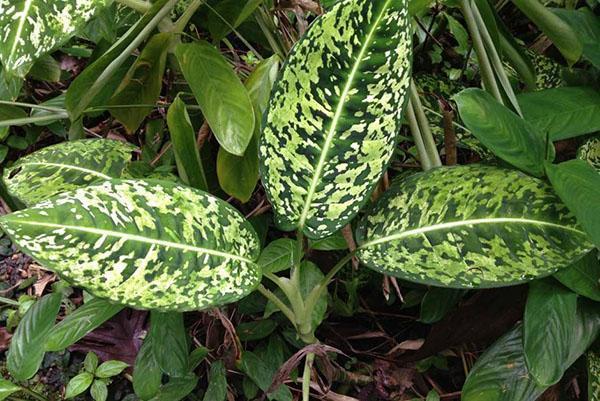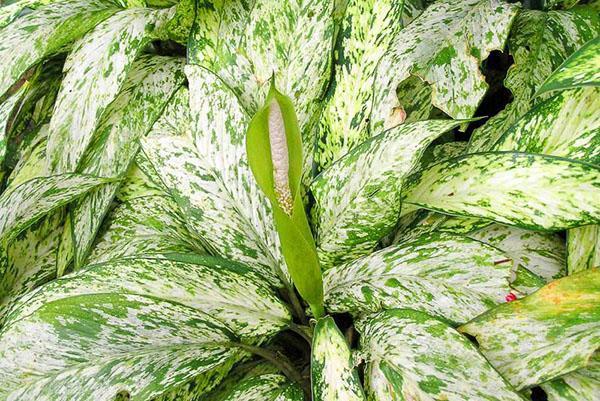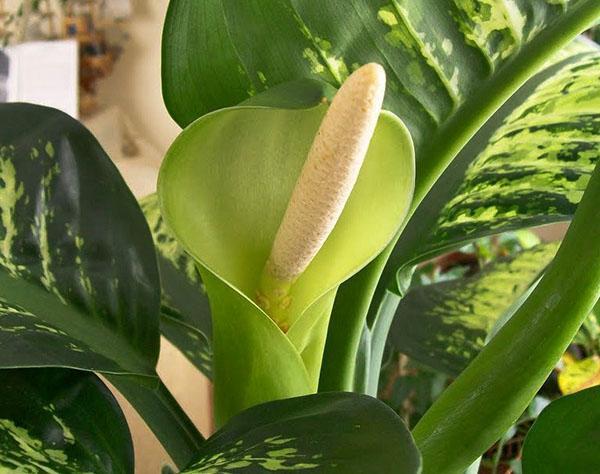Features of care for spotted dieffenbachia
 The genus Dieffenbachia has several dozen species naturally occurring in the tropical regions of the American continent. Only a few varieties are grown as an indoor pot culture, the most popular and common of which is Dieffenbachia spotted.
The genus Dieffenbachia has several dozen species naturally occurring in the tropical regions of the American continent. Only a few varieties are grown as an indoor pot culture, the most popular and common of which is Dieffenbachia spotted.
Description and features of dieffenbachia spotted
Due to some inconsistency in the modern classification of these plants, the species can appear under several names:
- dieffenbachia spotted or Dieffenbachia maculata;
- Dieffenbachia Seguine var. Seguine;
- Dieffenbachia variegated or Dieffenbachia picta.
With proper care, dieffenbachia spotted at home grows up to a meter in height. The plant:
- powerful erect, and with significant lengthening lodging shoots;
- large pointed-elliptical leaves, alternately seated and distinguished by variegated platinum leaf;
- cob-shaped inflorescences, covered with a greenish-white elongated veil;
- orange-red medium-sized juicy fruits.

Loss of foliage is a natural process, but with insufficient care, whether it is a lack of feeding, watering, or vice versa, excessive moisture in the soil, the plant begins to intensively get rid of the leaves. This is also facilitated by the blooming of spotted dieffenbachia.
How does Dieffenbachia bloom?
Becoming the owner of Dieffenbachia, many beginners and some experienced flower growers do not know that the plant not only gives decorative foliage, but also occasionally blooms. Moreover, the inflorescences of dieffenbachia spotted are quite large, and it is impossible not to notice them.
 When and how does Dieffenbachia bloom? Like other Aroids, they have the shape of a slender, elongated ear, located inside the bracts. The length of the inflorescence reaches 15–18 cm, and the veil is somewhat longer than the ear. Flowers are divided into male and female, but it is difficult to see them with the naked eye, they are so small.
When and how does Dieffenbachia bloom? Like other Aroids, they have the shape of a slender, elongated ear, located inside the bracts. The length of the inflorescence reaches 15–18 cm, and the veil is somewhat longer than the ear. Flowers are divided into male and female, but it is difficult to see them with the naked eye, they are so small.
Flowering most often occurs in the second half of spring. But if the grower admires for a long time how it blooms Dieffenbachia, pictured, this threatens the weakening of the plant and the rapid loss of its decorative effect. Therefore, future inflorescences appearing from the leaf sinuses are recommended to be cut out.
If the ear remains on the stem, after pollination, round-oval orange berries with black glossy seeds inside are tied and ripen on it.
Varietal dieffenbachia spotted
 In nature, it is impossible to see plants with leaves colored in all shades of green, silver and creamy white, as in cultivated varietal Dieffenbachia spotted.
In nature, it is impossible to see plants with leaves colored in all shades of green, silver and creamy white, as in cultivated varietal Dieffenbachia spotted.
Most flower growers who are fond of decorative leafy crops in their collection have Dieffenbachia Camille or, as the name of this popular Camille variety sounds correctly. For all spotted dieffenbachia, this or that degree of variegation of the leaf is characteristic.But here light specks and strokes in the center of the leaf plate merge, giving the plant a bright, uniquely sunny look.
The Tropical Tiki spotted dieffenbachia variety has its own peculiarity. In the center of the leaf, the green color becomes grayish-silver. And against its background, lighter or completely white spots are clearly visible.
Dieffenbachia Tropic Marianne can be considered the lightest available to growers. The green color remains only at the very edge of the leaf, while the rest of it has a pale yellow, creamy color. White streaks emphasize the assembled texture of the leaf plate.
The leaves of the Tropic Sun cultivar have a dark green canvas along the edge of the leaf and an equally bright central vein. In the center, the leaf has a lighter, grassy tint.
On pistachio leaves with speckled dark and light spots, the dieffenbachia of the spotted variety Rudolph Roehrs has dark edges and a central vein.
To get such beautiful memorable plants, the florist must provide competent and constant care for Dieffenbachia spotted at home, providing the flower with the most comfortable atmosphere.
One of the conditions for the decorativeness of variegated varieties is to grow with enough bright, but not scorching sun. If you remove the pot in the shade, the foliage loses its inherent color, the spots fade, and the stems are disproportionately stretched.
How to care for dieffenbachia? What conditions are optimal for the well-being and growth of an indoor flower?
Caring for dieffenbachia spotted at home
 In addition to properly organized lighting, plants need:
In addition to properly organized lighting, plants need:
- warmth and absence of drafts;
- moisture in soil and air;
- nutrient soil, the content in which macro- and microelements is regularly replenished with the help of dressings.
In summer, Dieffenbachia spotted is comfortable at 20–25 ° C. But with the onset of the cold season, the temperature in the room can be reduced or the flower can be moved to where it will be at 16-18 ° C. At the same time, the plant should not experience a deficit of solar or artificial light.
 Watering ornamental crops:
Watering ornamental crops:
- in summer, it is carried out when the surface layer of the substrate dries;
- in winter, with dry soil at a depth of several centimeters.
It is important not to overflow the flower, otherwise Dieffenbachia spotted suffers from a lack of oxygen and decay of the root system. Its foliage gradually turns yellow and dies off.
As needed, especially when the heating is running, the air in the room is additionally humidified, and the foliage is sprayed or wiped with a damp cloth.
 If the collection contains variegated varieties with a predominance of light shades, when feeding them, the grower has to very clearly dose nitrogen fertilizers. On the one hand, they help the aerial part to grow, on the other hand, they can negatively affect the decorative properties of the flower. Under the influence of this element, even the upper, traditionally brighter leaves of spotted dieffenbachia noticeably turn green.
If the collection contains variegated varieties with a predominance of light shades, when feeding them, the grower has to very clearly dose nitrogen fertilizers. On the one hand, they help the aerial part to grow, on the other hand, they can negatively affect the decorative properties of the flower. Under the influence of this element, even the upper, traditionally brighter leaves of spotted dieffenbachia noticeably turn green.